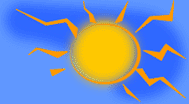|
 |
||||||||||
|
The "PHYSICS" of it all
Wave "physics" and the forces of buoyancy, gravity and friction
are critical in the ability to surf the waves. I did not realize how complicated the "Physics of Surfing" is until I
got into the research part of this project. Many of the terms I ran into about waves were familiar to me from Physics
class, such as: frequency, wavelength, velocity and amplitude. Several of the research articles I read were way over
my head when they got into talking about fluid dynamics, Froude Numbers, Gallilean Transformations and such. I have
tried to keep it all somewhat simple so almost anyone can understand it.
Balancing the forces involved is what makes surfing possible. Of course, if
the surfer can't balance on the board, the game's over. In a simplified view of this balance to start the ride, the
buoyancy force and force of the wave act in the same direction, the force of friction is opposite the direction the board
is headed and the force of gravity is down. When everything is in balance, the forces add up to zero (see the diagram
below).
After this, it gets more complicated.
|
|||||||||||
|
The point where a
wave changes from potential to kinetic energy is where the surfer starts his ride. The
forces of buoyancy, gravity, friction, and the push of the wave act upon the surfer and surfboard. To ‘take off’ or catch a wave, a rider will begin to paddle toward shore just before
the wave reaches his position. Paddling quickly provides the rider with enough
velocity to stay in front of the crest long enough for the momentum of the wave to be transferred to the rider. At rest, the wave would pass under the rider because the buoyancy of the surfboard would cause the rider
to float over the wave. Once the rider feels the force of the wave he stands
up. Gravity takes over at this point causing the rider to accelerate and glide
down the face of the wave. Buoyancy keeps the rider afloat, but with the increased
velocity of the initial drop, the board hydroplanes, or skims, across the water. The
steeper the angle of the face, the faster the ride will be. The goal is for the
momentum of the surfer to equal the momentum of the wave. Sliding
down the wave too fast will end the ride quickly. Slide down the wave too slowly
and the wave will outrun you or overrun you, usually resulting in a “wipeout” and sometimes a “sand facial”
*.
|
|||||||||||
 |
|||||||||||
|
|
|||||||||||

